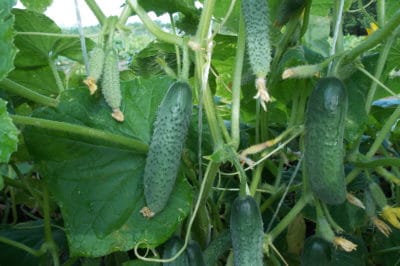How Cucumbers Climb
The secret to successfully growing cucumbers vertically lies in understanding just how cukes vines climb. Cucumbers do it with specially adapted leaves called tendrils. Here’s how the tendrils work:
- Tendrils begin as straight stems that lengthen in search of suitable support.
- Once both ends find a toehold, each tendril coils into a corkscrew with an uncoiled stretch separating its two halves.
- The two halves coil in opposite directions. If they didn’t, the tendrils would end up twisting the entire vine.
Expert gardener’s tip: This coling magic happens thanks to a two-layered ribbon of cells inside each tendril. The water-repelling inner cells stiffen as they age, giving the vines have a strong, flexible grip that tolerates wind without snapping.
Tendrils Need Horizontal Toeholds
Coiling cuke tendrils can’t grow vertically without horizontal support. While this limits your choice of effective trellises, you still have plenty of budget-friendly alternatives. For lightweight durability, we suggest this one:
The Steel Panel Tent Trellis
Find the materials you need for this trellis at your home and garden store and arrange for a second pair of hands to be available on the day you build it. Choose a time when the ground is soft.
- One 50-inch steel fence panel with 4- to 6-inch grids (usually sold in a 16-foot length)
- Measuring tape
- Marking pen
- Heavy garden gloves
- Bolt cutters
- Measure and mark your fence panel into thirds or halves, depending on your desired trellis length.
- Wearing gloves, cut the panel into the desired lengths with the bolt cutters.
- Bend each length into a tent with help from your second pair of hands.
- Snip the lowest horizontal wires from each side of the trellises to create staked supports.
- Hold the trellises upright and push their staked bases into the soil for stability.
- Plant your cukes along one side of the trellises; they’ll latch onto the wired grids and climb up and over the other sides.
Expert gardener’s tip: To avoid damaging developing roots, always have your trellises in place before planting.
